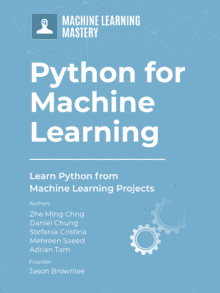The source code of a program should be readable to humans. Making it run correctly is only half of its purpose. Without a properly commenting code, it would be difficult for one, including the future you, to understand the rationale and intent behind the code. It would also make the code impossible to maintain. In Python, there are multiple ways to add descriptions to the code to make it more readable or make the intent more explicit. In the following, we will see how we should properly use comments, docstrings, and type hints to make our code easier to understand. After finishing this tutorial, you will know:
- What is the proper way of using comments in Python
- How string literal or docstring can replace comments in some cases
- What are type hints in Python, and how they can help us understand the code better
Kick-start your project with my new book Python for Machine Learning, including step-by-step tutorials and the Python source code files for all examples.
Let’s get started.
Comments, Docstrings, and Type Hints in Python Code. Photo by Rhythm Goyal. Some rights reserved
Overview
This tutorial is in three parts, they are:
- Adding comments to Python code
- Using docstrings
- Using type hints in Python code
Adding Comments to Python Code
Almost all programming languages have dedicated syntax for comments. Comments are to be ignored by compilers or interpreters, and hence they have no effect on the programming flow or logic. But with comments, it is easier to read the code.
In languages like C++, we can add “inline comments” with a leading double slash (//) or add comment blocks enclosed by /* and */. However, in Python, we only have the “inline” version, and they are introduced by the leading hash character (#).
It is quite easy to write comments to explain every line of code, but that is usually a waste. When people read the source code, comments often easily catch their attention, and hence putting too many comments would distract the reading. For example, the following is unnecessary and distracting:
|
1 2 3 4 |
import datetime timestamp = datetime.datetime.now() # Get the current date and time x = 0 # initialize x to zero |
Comments like these are merely repeating what the code does. Unless the code is obscure, these comments add no value to the code. The example below might be a marginal case in which the name “ppf” (percentage point function) is less well-known than the term “CDF” (cumulative distribution function):
|
1 2 3 |
import scipy.stats z_alpha = scipy.stats.norm.ppf(0.975) # Call the inverse CDF of standard normal |
Good comments should tell why we are doing something. Let’s look at the following example:
|
1 2 3 4 5 6 7 8 9 10 11 12 13 14 15 16 17 18 19 20 21 22 23 24 25 26 27 28 29 30 31 |
def adadelta(objective, derivative, bounds, n_iter, rho, ep=1e-3): # generate an initial point solution = bounds[:, 0] + rand(len(bounds)) * (bounds[:, 1] - bounds[:, 0]) # lists to hold the average square gradients for each variable and # average parameter updates sq_grad_avg = [0.0 for _ in range(bounds.shape[0])] sq_para_avg = [0.0 for _ in range(bounds.shape[0])] # run the gradient descent for it in range(n_iter): gradient = derivative(solution[0], solution[1]) # update the moving average of the squared partial derivatives for i in range(gradient.shape[0]): sg = gradient[i]**2.0 sq_grad_avg[i] = (sq_grad_avg[i] * rho) + (sg * (1.0-rho)) # build a solution one variable at a time new_solution = list() for i in range(solution.shape[0]): # calculate the step size for this variable alpha = (ep + sqrt(sq_para_avg[i])) / (ep + sqrt(sq_grad_avg[i])) # calculate the change and update the moving average of the squared change change = alpha * gradient[i] sq_para_avg[i] = (sq_para_avg[i] * rho) + (change**2.0 * (1.0-rho)) # calculate the new position in this variable and store as new solution value = solution[i] - change new_solution.append(value) # evaluate candidate point solution = asarray(new_solution) solution_eval = objective(solution[0], solution[1]) # report progress print('>%d f(%s) = %.5f' % (it, solution, solution_eval)) return [solution, solution_eval] |
The function above is implementing the AdaDelta algorithm. In the first line, when we assign something to the variable solution, we do not write comments like “a random interpolation between bounds[:,0] and bounds[:,1]” because that is just repeating the code. We say the intent of this line is to “generate an initial point.” Similarly, for the other comments in the function, we mark one of the for-loops as the gradient descent algorithm rather than just saying iterate for certain times.
One important issue we want to remember when writing the comment or modifying code is to make sure the comment accurately describes the code. If they contradict, it would be confusing to the readers. So should we not have put the comment on the first line of the above example to “set initial solution to the lowerbound” while the code obviously randomizes the initial solution, or vice versa. If this is what you intended to do, you should update the comment and the code at the same time.
An exception would be the “to-do” comments. From time to time, when we have an idea on how to improve the code but have not yet changed it, we may put to-do comments on the code. We can also use it to mark incomplete implementations. For example,
|
1 2 3 4 5 6 7 8 |
# TODO replace Keras code below with Tensorflow from keras.models import Sequential from keras.layers import Conv2D model = Sequential() model.add(Conv2D(1, (3,3), strides=(2, 2), input_shape=(8, 8, 1))) model.summary() ... |
This is a common practice, and many IDE will highlight the comment block differently when the keyword TODO is found. However, it’s supposed to be temporary, and we should not abuse it as an issue-tracking system.
In summary, some common “best practices” on commenting code are listed as follows:
- Comments should not restate the code but explain it
- Comments should not cause confusion but eliminate it
- Put comments on code that is not trivial to understand; for example, state the unidiomatic use of syntax, name the algorithm being used, or explain the intent or assumptions
- Comments should be concise and simple
- Keep a consistent style and use of language in commenting
- Always prefer to have a better-written code that needs no additional comments
Using Docstrings
In C++, we may write a large block of comments such as in the following:
|
1 2 3 4 5 6 7 8 9 10 11 12 13 14 15 16 17 18 19 20 21 22 23 24 25 26 27 28 |
TcpSocketBase::~TcpSocketBase (void) { NS_LOG_FUNCTION (this); m_node = nullptr; if (m_endPoint != nullptr) { NS_ASSERT (m_tcp != nullptr); /* * Upon Bind, an Ipv4Endpoint is allocated and set to m_endPoint, and * DestroyCallback is set to TcpSocketBase::Destroy. If we called * m_tcp->DeAllocate, it will destroy its Ipv4EndpointDemux::DeAllocate, * which in turn destroys my m_endPoint, and in turn invokes * TcpSocketBase::Destroy to nullify m_node, m_endPoint, and m_tcp. */ NS_ASSERT (m_endPoint != nullptr); m_tcp->DeAllocate (m_endPoint); NS_ASSERT (m_endPoint == nullptr); } if (m_endPoint6 != nullptr) { NS_ASSERT (m_tcp != nullptr); NS_ASSERT (m_endPoint6 != nullptr); m_tcp->DeAllocate (m_endPoint6); NS_ASSERT (m_endPoint6 == nullptr); } m_tcp = 0; CancelAllTimers (); } |
But in Python, we do not have an equivalent to the delimiters /* and */, but we can write multi-line comments using the following instead:
|
1 2 3 4 5 6 7 8 9 10 11 12 13 14 15 16 17 18 19 20 21 |
async def main(indir): # Scan dirs for files and populate a list filepaths = [] for path, dirs, files in os.walk(indir): for basename in files: filepath = os.path.join(path, basename) filepaths.append(filepath) """Create the "process pool" of 4 and run asyncio. The processes will execute the worker function concurrently with each file path as parameter """ loop = asyncio.get_running_loop() with concurrent.futures.ProcessPoolExecutor(max_workers=4) as executor: futures = [loop.run_in_executor(executor, func, f) for f in filepaths] for fut in asyncio.as_completed(futures): try: filepath = await fut print(filepath) except Exception as exc: print("failed one job") |
This works because Python supports declaring a string literal spanning across multiple lines if it is delimited with triple quotation marks ("""). And a string literal in the code is merely a string declared with no impact. Therefore it is functionally no different than the comments.
One reason we want to use string literals is to comment out a large block of code. For example,
|
1 2 3 4 5 6 7 8 9 10 11 12 13 14 15 |
from sklearn.linear_model import LogisticRegression from sklearn.datasets import make_classification """ X, y = make_classification(n_samples=5000, n_features=2, n_informative=2, n_redundant=0, n_repeated=0, n_classes=2, n_clusters_per_class=1, weights=[0.01, 0.05, 0.94], class_sep=0.8, random_state=0) """ import pickle with open("dataset.pickle", "wb") as fp: X, y = pickle.load(fp) clf = LogisticRegression(random_state=0).fit(X, y) ... |
The above is a sample code that we may develop by experimenting with a machine learning problem. While we generated a dataset randomly at the beginning (the call to make_classification() above), we may want to switch to a different dataset and repeat the same process at a later time (e.g., the pickle part above). Rather than removing the block of code, we may simply comment on those lines so that we can store the code later. It is not in good shape for the finalized code but convenient while developing our solution.
The string literal in Python as a comment has a special purpose if it is in the first line under a function. The string literal, in that case, is called the “docstring” of the function. For example,
|
1 2 3 4 5 6 7 8 9 10 |
def square(x): """Just to compute the square of a value Args: x (int or float): A numerical value Returns: int or float: The square of x """ return x * x |
We can see the first line under the function is a literal string, and it serves the same purpose as a comment. It makes the code more readable, but at the same time, we can retrieve it from the code:
|
1 2 |
print("Function name:", square.__name__) print("Docstring:", square.__doc__) |
|
1 2 3 4 5 6 7 8 |
Function name: square Docstring: Just to compute the square of a value Args: x (int or float): A numerical value Returns: int or float: The square of x |
Because of the special status of the docstring, there are several conventions on how to write a proper one.
In C++, we may use Doxygen to generate code documentation from comments, and similarly, we have Javadoc for Java code. The closest match in Python would be the tool “autodoc” from Sphinx or pdoc. Both will try to parse the docstring to generate documentation automatically.
There is no standard way of making docstrings, but generally, we expect they will explain the purpose of a function (or a class or module) as well as the arguments and the return values. One common style is like the one above, which is advocated by Google. A different style is from NumPy:
|
1 2 3 4 5 6 7 8 9 10 11 12 13 14 |
def square(x): """Just to compupte the square of a value Parameters ---------- x : int or float A numerical value Returns ------- int or float The square of `x` """ return x * x |
Tools such as autodoc can parse these docstrings and generate the API documentation. But even if it is not the purpose, having a docstring describing the nature of the function, the data types of the function arguments and return values can surely make your code easier to read. This is particularly true since Python, unlike C++ or Java, is a duck-typing language in which variables and function arguments are not declared with a particular type. We can make use of docstrings to spell out the assumptions of the data type so people can more easily follow or use your function.
Want to Get Started With Python for Machine Learning?
Take my free 7-day email crash course now (with sample code).
Click to sign-up and also get a free PDF Ebook version of the course.
Using Type Hints in Python Code
Since Python 3.5, type hint syntax is allowed. As the name implies, its purpose is to hint at the type and nothing else. Hence even if it looks to bring Python closer to Java, it does not mean to restrict the data to be stored in a variable. The example above can be rewritten with a type hint:
|
1 2 |
def square(x: int) -> int: return x * x |
In a function, the arguments can be followed by a : type syntax to spell out the intended types. The return value of a function is identified by the -> type syntax before the colon. In fact, a type hint can be declared for variables too, e.g.,
|
1 2 3 |
def square(x: int) -> int: value: int = x * x return value |
The benefit of a type hint is twofold: We can use it to eliminate some comments if we need to describe explicitly the data type being used. We can also help static analyzers understand our code better so they can help identify potential issues in the code.
Sometimes the type can be complex, and therefore Python provided the typing module in its standard library to help clean up the syntax. For example, we can use Union[int,float] to mean int type or float type, List[str] to mean a list that every element is a string, and use Any to mean anything. Like as follows:
|
1 2 3 4 5 6 7 |
from typing import Any, Union, List def square(x: Union[int, float]) -> Union[int, float]: return x * x def append(x: List[Any], y: Any) -> None: x.append(y) |
However, it is important to remember that type hints are hints only. It does not impose any restrictions on the code. Hence the following is confusing to the reader but perfectly fine:
|
1 2 |
n: int = 3.5 n = "assign a string" |
Using type hints may improve the readability of the code. However, the most important benefit of type hints is to allow a static analyzer such as mypy to tell us whether our code has any potential bugs. If you process the above lines of code with mypy, we will see the following error:
|
1 2 3 |
test.py:1: error: Incompatible types in assignment (expression has type "float", variable has type "int") test.py:2: error: Incompatible types in assignment (expression has type "str", variable has type "int") Found 2 errors in 1 file (checked 1 source file) |
The use of static analyzers will be covered in another post.
To illustrate the use of comments, docstrings, and type hints, below is an example to define a generator function that samples a pandas DataFrame on fixed-width windows. It is useful for training an LSTM network, in which a few consecutive time steps should be provided. In the function below, we start from a random row on the DataFrame and clip a few rows following it. As long as we can successfully get one full window, we take it as a sample. Once we’ve collected enough samples to make a batch, the batch is dispatched.
You should see that it is clearer if we can provide type hints on the function arguments, so we know, for example, that data is supposed to be a pandas DataFrame. But we describe further that it is expected to carry a datetime index in the docstring. We describe the algorithm on how to exact a window of rows from the input data as well as the intention of the “if” block in the inner while-loop using comments. In this way, the code is much easier to understand and much easier to maintain or modify for other use.
|
1 2 3 4 5 6 7 8 9 10 11 12 13 14 15 16 17 18 19 20 21 22 23 24 25 26 27 28 29 30 31 32 33 34 35 36 37 38 39 40 41 42 43 44 |
from typing import List, Tuple, Generator import pandas as pd import numpy as np TrainingSampleGenerator = Generator[Tuple[np.ndarray,np.ndarray], None, None] def lstm_gen(data: pd.DataFrame, timesteps: int, batch_size: int) -> TrainingSampleGenerator: """Generator to produce random samples for LSTM training Args: data: DataFrame of data with datetime index in chronological order, samples are drawn from this timesteps: Number of time steps for each sample, data will be produced from a window of such length batch_size: Number of samples in each batch Yields: ndarray, ndarray: The (X,Y) training samples drawn on a random window from the input data """ input_columns = [c for c in data.columns if c != "target"] batch: List[Tuple[pd.DataFrame, pd.Series]] = [] while True: # pick one start time and security while True: # Start from a random point from the data and clip a window row = data["target"].sample() starttime = row.index[0] window: pd.DataFrame = data[starttime:].iloc[:timesteps] # If we are at the end of the DataFrame, we can't get a full # window and we must start over if len(window) == timesteps: break # Extract the input and output y = window["target"] X = window[input_columns] batch.append((X, y)) # If accumulated enough for one batch, dispatch if len(batch) == batch_size: X, y = zip(*batch) yield np.array(X).astype("float32"), np.array(y).astype("float32") batch = [] |
Further reading
This section provides more resources on the topic if you are looking to go deeper.
Articles
- Best practices for writing code comments, https://stackoverflow.blog/2021/12/23/best-practices-for-writing-code-comments/
- PEP483, the theory of type hints, https://www.python.org/dev/peps/pep-0483/
- Google Python Style Guide, https://google.github.io/styleguide/pyguide.html
Software
- Sphinx documentation, https://www.sphinx-doc.org/en/master/index.html
- Napoleon module of Sphinx, https://sphinxcontrib-napoleon.readthedocs.io/en/latest/index.html
- Google-style docstring example: https://sphinxcontrib-napoleon.readthedocs.io/en/latest/example_google.html
- NumPy-style docstring example: https://sphinxcontrib-napoleon.readthedocs.io/en/latest/example_numpy.html
- pdoc, https://pdoc.dev/
- typing module, https://docs.python.org/3/library/typing.html
Summary
In this tutorial, you’ve seen how we should use the comments, docstrings, and type hints in Python. Specifically, you now know:
- How to write a good, useful comment
- The conventions in explaining a function using docstrings
- How to use type hints to address the readability weakness of duck-typing in Python








Please have a native English speaker review / edit the commentary.